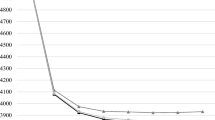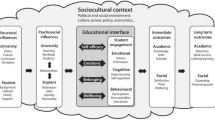Abstract
Using data from the 2006 cohort of the Wabash National Study of Liberal Arts Education, we developed a student typology based on student responses to survey items on the National Survey of Student Engagement. We then examined the utility of this typology in understanding direct-assessment learning outcomes, self-reported gains, grade-point average, and persistence from the first to second year of college. Results from linear and logistic regression models indicated there were relationships between student types and the various outcomes, and that an engagement-based student typology could help deepen our understanding of the college student experience and college outcomes.

Similar content being viewed by others
Notes
More information about the WNSLAE is available at www.liberalarts.wabash.edu/study-design.
References
Allison, P. D. (1990). Change scores as dependent variables in regression analysis. Sociological Methodology, 20, 93–114.
Arum, R., & Roksa, J. (2011). Academically adrift: Limited learning on college campuses. Chicago: The University of Chicago Press.
Association of American Colleges and Universities (AAC&U). (2007). College learning for the new global century. Washington, DC: Author.
Astin, A. W. (1993a). An empirical typology of college students. Journal of College Student Development, 34(1), 36–46.
Astin, A. W. (1993b). Assessment for excellence: The philosophy and practice of assessment and evaluation in higher education. Phoenix, AZ: American Council for Education and Oryx Press.
Astin, A. W. (1993c). What matters in college: Four critical years revisited. San Francisco: Jossey-Bass.
Astin, A. W. (1999). Student involvement: A developmental theory for higher education. Journal of College Student Development, 40, 518–529.
Bahr, P. R. (2010). The bird’s eye view of community colleges: A behavioral typology of first-time students based on cluster analytic classification. Research in Higher Education, 51, 724–749.
Bailey, K. D. (1994). Typologies and taxonomies: An introduction to classification techniques. Sage University papers. Quantitative applications in the social sciences, No. 07-102. Thousand Oaks, CA: Sage.
Bok, D. C. (2007). Our underachieving colleges: A candid look at how much students learn and why they should be learning more. Princeton, NJ: Princeton University Press.
Bowman, N. A. (2009). Can 1st-year college students accurately report their learning and development? American Educational Research Journal, 47, 466–496.
Bowman, N. A. (2011). Examining systematic errors in predictors of college student self-reported gains. New Directions for Institutional Research, 150, 7–19.
Cacioppo, J., Petty, R., Feinstein, J., & Jarvis, W. (1996). Dispositional differences in cognitive motivation: The life and times of individuals varying in need for cognition. Psychological Bulletin, 119, 197–253.
Chickering, A. W., & Gamson, Z. F. (1987). Seven principles for good practice in undergraduate education. AAHE Bulletin, May, 3–7.
Clark, B. R., & Trow, M. (1966). The organizational context. In T. M. Newcomb & E. K. Wilson (Eds.), College peer groups: Problems and prospects for research (pp. 17–70). Chicago: Aldine.
Cohen, J. (1977). Statistical power analysis for the behavioral sciences (Rev. ed.). New York: Academic Press.
Flacks, R., & Thomas, S. L. (2007). ‘Outsiders’, student subcultures, and the massification of higher education. In J. C. Smart (Ed.), Higher education: Handbook of theory and research (pp. 181–218). New York: Springer.
Gonyea, R. M., & Miller, A. (2011). Clearing the AIR about the use of self-reported gains in institutional research. New Directions for Institutional Research, 150, 99–111.
Gonzalez, J. (2010, Aug 9). In Texas speech, Obama renews his educational goals for the nation. Chronicle of Higher Education, Daily News.
Hu, S. (2005). Beyond grade inflation: Grading problems in higher education. San Francisco: Jossey-Bass.
Hu, S., & Kuh, G. D. (2003). Maximizing what students get out of college: Testing a learning productivity model. Journal of College Student Development, 44, 185–203.
Hu, S., & Li, S. (Eds.) (2011). Using typological approaches to understand college student experiences and outcomes. New Directions for Institutional Research, Assessment Supplement 2011. San Francisco: Jossey-Bass.
Hu, S., McCormick, A. C., & Gonyea, R. M. (in press). Examining the relationship between student learning and persistence. Innovative Higher Education.
Kuh, G. D. (2008). High-impact educational practices: What they are, who has access to them, and why they matter. Washington, DC: Association of American Colleges and Universities.
Kuh, G. D., Cruce, T. M., Shoup, R., Kinzie, J., & Gonyea, R. M. (2008). Unmasking the effects of student engagement on first-year college grades and persistence. Journal of Higher Education, 79, 540–563.
Kuh, G. D., Hu, S., & Vesper, N. (2000). “They shall be known by what they do”: An activities based typology of college students. Journal of College Student Development, 41(2), 228–244.
Kuh, G. D., Kinzie, J., Buckley, J., Bridges, B., & Hayek, J. (2007). Piecing together the student success puzzle: Research, propositions, and recommendations. ASHE Higher Education Report, Vol 32, No 5. San Francisco: Jossey-Bass.
Lorr, M. (1983). Cluster analysis for social scientists. San Francisco: Jossey-Bass.
Luan, J., Zhao, C., & Hayek, J. (2009). Using a data mining approach to develop a student engagement-based institutional typology IR Applications, 18. Tallahassee, FL: Association for Institutional Research.
Mitchell, V. W. (1994). Using factor, cluster, and determinant analysis to identify psychographic segments. Marketing working paper series, No. 9308. Manchester School of Management.
Miville, M., Gelso, C., Pannu, R., Liu, W., Touradji, P., Holloway, P., et al. (1999). Appreciating similarities and valuing differences: The Miville–Guzman Universality-Diversity Scale. Journal of Counseling Psychology, 46(3), 291–307.
National Center for Public Policy and Higher Education. (2004). Measuring up 2004. San Jose, CA: Author.
National Commission on the Future of Higher Education. (2006). A test of leadership: Charting the future of U.S. higher education. Washington, DC: US Department of Education.
National Survey of Student Engagement. (2004). Student engagement: Pathways to collegiate success. Bloomington, IN: Indiana University Center for Postsecondary Research.
National Survey of Student Engagement. (2005). Student engagement: Exploring different dimensions of student engagement. Bloomington, IN: Indiana University Center for Postsecondary Research.
National Survey of Student Engagement. (2008). Promoting engagement for all students: The imperative to look within. Bloomington, IN: Indiana University Center for Postsecondary Research.
Pace, C. R. (1980). Measuring the quality of student effort. Current Issues in Higher Education, 2, 10–16.
Pascarella, E. T. (1985). College environmental influences on learning and cognitive development: A critical review and synthesis. In J. C. Smart (Ed.), Higher education: Handbook of theory and research, Vol. I (pp. 1–64). New York: Agathon.
Pascarella, E. T., Seifert, T. A., & Blaich, C. (2010). How effective are the NSSE benchmarks in predicting important educational outcomes? Change, 42(1), 16–22.
Pascarella, E. T., & Terenzini, P. T. (1991). How college affects students: Findings and insights from 20 years of research. San Francisco: Jossey-Bass.
Pascarella, E. T., & Terenzini, P. T. (2005). How college affects students: A third decade of research. San Francisco: Jossey-Bass.
Ryff, C. (1989). Happiness is everything, or is it? Explorations on the meaning of psychological well-being. Journal of Personality and Social Psychology, 57, 1069–1081.
Ryff, C., & Keyes, C. (1995). The structure of psychological well-being revisited. Journal of Personality and Social Psychology, 69, 719–727.
Tinto, V. (1998). Colleges as communities: Taking research on student persistence seriously. Review of Higher Education, 21, 167–177.
Tyree, T. (1998). Designing an instrument to measure socially responsible leadership using the social change model of leadership development. Unpublished doctoral dissertation, University of Maryland-College Park.
Wolniak, G. C, Mayhew, M. J., & Engberg, M. E. (2012). Learning’s weak link to persistence. Journal of Higher Education (in press).
Zhao, C. M., Gonyea, R. M., & Kuh, G. D. (2003, May). The psychographic typology: Toward higher resolution research on college students. Paper presented at the Annual Forum of the Association for Institutional Research, Tampa, FL.
Acknowledgments
The authors wish to thank Charles Blaich and the Wabash Center of Inquiry in the Liberal Arts for granting access to the data used in this study. The findings reported here reflect only the authors’ analyses and interpretations, and not official positions of the Center of Inquiry or its sponsoring organizations.
Author information
Authors and Affiliations
Corresponding author
Rights and permissions
About this article
Cite this article
Hu, S., McCormick, A.C. An Engagement-Based Student Typology and Its Relationship to College Outcomes. Res High Educ 53, 738–754 (2012). https://doi.org/10.1007/s11162-012-9254-7
Received:
Published:
Issue Date:
DOI: https://doi.org/10.1007/s11162-012-9254-7




